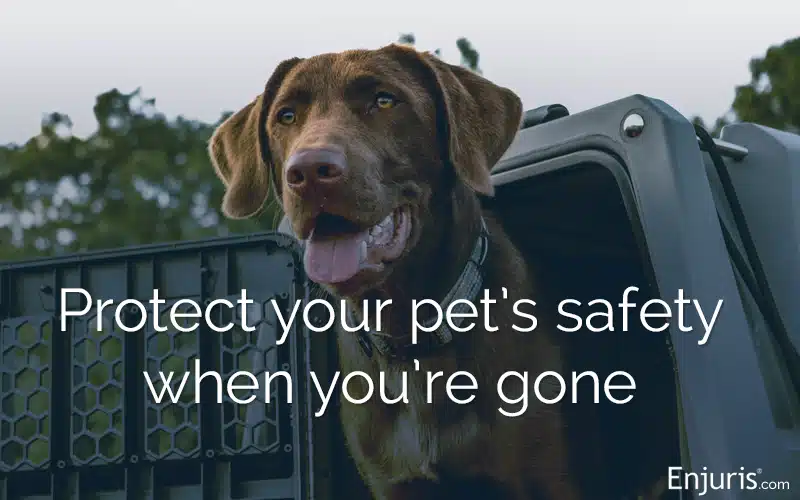
Last year, pet owners in the United States spent over $12.3 billion on boarding and grooming services—a solid chunk of the whopping $147 billion spent on pets, according to the American Pet Products Association.
The bottom line: Americans treat their pets like family (maybe even better than some family members).
But what happens if your pet is injured—or worse—while at one of these facilities? In this post, we break down your legal options if your pet is harmed during boarding. We’ll cover where you might leave your pet, the red flags to watch out for, the legal responsibilities of these facilities, and the types of damages you may be able to recover if something goes wrong.
Types of pet boarding facilities and potential red flags
Pet boarding facilities can vary widely in terms of the services they provide. Here’s a breakdown:
- Kennels: Typically provide basic care, including food, water, and some exercise.
- Pet boarding centers: These places usually provide a range of services beyond the basics, such as play areas and grooming.
- Pet daycare facilities: These facilities cater to pet owners looking for a temporary care solution while they’re at work, generally only during business hours.
- Pet hotels: Higher-end facilities often include luxury options like private suites, TV for pets, and customized food plans.
The Ings Luxury Cat Hotel, nestled in the beautiful English countryside, offers amenities like heated floors, plush bedding with high-quality linens, LED TVs, and VIP spa treatment packages.
When selecting a boarding facility, watch for these red flags:
- Unclear policies on emergency veterinary care: Reliable facilities have a clear plan for emergencies and provide detailed instructions on handling health incidents.
- Insufficient staff: Look for a caregiver-to-pet ratio of at least one staff member for every 15–20 pets. An understaffed facility may struggle to provide proper supervision and could be unprepared to respond quickly in an emergency.
- Poor cleanliness or strong odors: A quality facility should be clean and odor-free. Strong smells or visible dirt could point to deeper maintenance issues.
- Restricted tours or access: Reputable facilities welcome visitors to tour their spaces. If a facility hesitates to show you where your pet will stay, it may be hiding something.
Legal obligations of boarding facilities
When you leave your pet at a boarding facility, the business assumes a certain “duty of care” for your pet’s well-being. While the specifics vary by state, here’s an overview of the general obligations:
- Basic care: Boarding facilities must provide basic necessities like food, water, shelter, and exercise, depending on the duration of the pet’s stay.
- Safe environment: Facilities must maintain safe and clean conditions to prevent injury or illness. This includes regular cleaning, proper food storage, and measures to avoid fights between animals.
- Medical attention: If your pet requires emergency care, most facilities are expected to make a reasonable effort to seek veterinary assistance.
What About Waivers?
When you drop off your pet, many boarding facilities require you to sign a waiver or liability release. These waivers often aim to limit the facility’s responsibility for injuries or illnesses that may occur while your pet is under their care. However, signing a waiver doesn’t necessarily mean you waive all rights.
In many states, waivers can release facilities from liability for ordinary negligence—for example, an accidental slip-up in pet supervision. This is fairly standard in boarding facility waivers, as facilities aim to limit claims related to minor, unintended incidents. However, waivers generally cannot protect facilities from gross negligence or intentional behavior. For instance, if the facility failed to follow basic safety protocols or ignored an obvious injury, a waiver is unlikely to shield them from liability.
Some states, such as Virginia, Montana, and Louisiana, don’t allow pet boarding facilities to use waivers to absolve themselves of liability at all. Other states, including Arizona, New Mexico, and West Virginia, severely restrict the use of waivers. This means that depending on your state’s laws, the facility may still be accountable even if you signed a waiver, especially in cases where negligence exceeds what’s considered ordinary.
Elements of a lawsuit against a boarding facility
If you decide to sue a boarding facility, you’ll generally need to establish the four elements of negligence:
- Duty of care: As mentioned earlier, the facility has a duty to provide a safe environment and meet your pet’s basic needs.
- Breach of duty: You must prove that the facility failed to uphold this duty.
- Causation: The injury must be directly linked to the facility’s breach of duty. If your pet comes home with a broken leg, you’ll need to prove that their leg would not have been broken but for the actions (or inactions) of the facility.
- Damages: Finally, you’ll need to show that you suffered financial or emotional damages because of the injury.
Imagine you leave your cat, Luna, at a boarding facility. During her stay, the facility fails to separate larger dogs from smaller animals in the play area, and Luna is bitten by a dog. Staff members do not seek medical care, and as a result, Luna’s injuries worsen.
If you decide to pursue a lawsuit, you’ll need to prove the four elements listed above to establish that the facility didn’t uphold its duty of care, which directly led to Luna’s injuries and your veterinary expenses.
First, you’ll need to establish that the pet hotel had a duty of care toward Luna, meaning they were responsible for her safety while in their care. This duty is typically easy to prove and can be demonstrated by referencing the facility’s policies, promotional materials, or waivers, which likely assure pet owners of a safe environment for all animals.
To prove that the facility breached this duty, you would look for evidence showing that they neglected basic safety practices. For instance, you might review the facility’s security footage and depose staff members.
Next, you’ll need to show that the facility’s failure to meet safety standards caused Luna’s injuries. Veterinary records documenting the bite wounds, as well as statements from the veterinarian describing how timely treatment could have minimized her suffering, would strengthen this part of your case.
Finally, to recover damages, you’ll need to prove your financial losses. Detailed records of veterinary bills will help establish the monetary impact. Photos of Luna’s injuries and documentation of her health before and after the incident can underscore the emotional and physical toll of the facility’s actions on both you and Luna.
Damages you can claim if your pet is injured
While we often see our pets as cherished family members, the legal system views them differently when it comes to injuries or even death. Unlike the compensation available for the loss of a human family member—where damages often include pain and suffering, companionship, and emotional loss—recovery for harm done to a pet is generally limited to financial losses. Courts typically categorize pets as personal property rather than family members, which greatly impacts the types of damages you can claim.
In most cases, you’re entitled only to the pet’s fair market value, a figure based on factors like breed, age, and pedigree. For example, a purebred show dog or rare breed may have a higher market value than a typical pet, but courts treat this as a replacement cost rather than recognizing your pet’s unique role in your life. The bottom line: you can typically recover only what it would cost to buy a “replacement” pet.
Most states also allow for the recovery of veterinary expenses related to the injury. If your pet survives but requires extensive medical treatment, you may be able to recover these costs. However, these claims may still be capped by the fair market value of the pet.
In a few jurisdictions, courts are beginning to recognize the unique bond between pets and their owners by allowing recovery of noneconomic damages, such as compensation for the emotional toll the injury caused. However, these cases are still the exception rather than the rule.
Ultimately, the current legal system prioritizes a pet’s financial value over the emotional bond owners feel, which can make it difficult to find a lawyer willing to take on these cases. Other options to consider include:
- Small Claims Court: For cases with relatively low monetary damages, small claims court can be an accessible route. These courts typically handle disputes up to a certain dollar limit (often between $2,500 and $10,000).
- Demand Letter: Writing a letter to the facility owner detailing the incident and requesting compensation may lead to a settlement without the need for court involvement.
- Pet Advocacy Groups: Some states have organizations that advocate for pet owners in cases of neglect or harm. While these groups may not provide direct legal assistance, they often offer resources and support to help you pursue your claim.
Thinking about going to court without a lawyer? View our guide to pro se litigation.
How long do you have to sue?
All states have statutes of limitations for pet injury cases, typically ranging from one to six years. This time limit usually begins on the date of the injury or when you first became aware of it. If you don’t file a lawsuit within the allowed timeframe, you lose the right to sue and recover damages permanently.
If your pet has been injured due to a boarding facility’s negligence, navigating the legal system can be challenging. Consider reaching out to a knowledgeable attorney who can assess your case, guide you on potential damages, and help ensure you’re taking the right steps to seek justice for your pet.
Can I Sue My Veterinarian for an Injury to My Pet?
When your doctor commits medical malpractice, you can file a medical malpractice lawsuit to recover damages. But what happens when your veterinarian injures your pet? Can they be sued?

